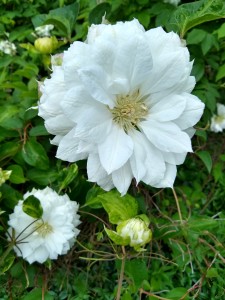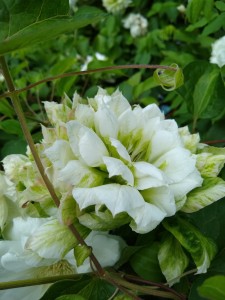 I frequently tell people that my garden speaks and sometimes even sings to me. What I don’t say is that the voices are in many different languages. Any given plant might have ancestry going back to one or more species native to Asia, Africa or one of the world’s many other cradles of botanical diversity. Seeds or cuttings of those ancestor species eventually made their way to Europe or America, where plant breeders worked with them to produce hybrid offspring. That hybridization process often involved many generations of crosses and recrosses, until those procedures produced the plants that we buy at garden centers today.
I frequently tell people that my garden speaks and sometimes even sings to me. What I don’t say is that the voices are in many different languages. Any given plant might have ancestry going back to one or more species native to Asia, Africa or one of the world’s many other cradles of botanical diversity. Seeds or cuttings of those ancestor species eventually made their way to Europe or America, where plant breeders worked with them to produce hybrid offspring. That hybridization process often involved many generations of crosses and recrosses, until those procedures produced the plants that we buy at garden centers today.
‘Duchess of Edinburgh’, a stupendous double white clematis that grows in my front garden, arrived on my doorstep by that route. A member of the buttercup or Ranunculaceae family, its ancestors were Chinese species like Clematis languinosa, white or lavender-flowered climber with compound leaves; or Clematis patens, also with violet to white flowers and pairs or trios of leaflets. In the nineteenth century, when plant hunters were returning from far-flung regions with hundreds of new plant species, those ancestor clematis arrived in western Europe.
The first successful attempt to hybridize large-flowered clematis came in 1835, and the new hybrid was christened Clematis hendersonii, after the hybridizer, Mr. Henderson. ‘Duchess of Edinburgh’ owes its existence to George Jackman and his son, George Jackman II, who began their own clematis hybridizing efforts in 1858. Their efforts ultimately led to their first successful introduction, the showy Clematis ‘Jackmanii’.
Still available and popular today, ‘Jackmanii’ boasts four or five-inch purple flowers with a faint pinkish-purple stripe in the middle of each rounded petal. It won a Royal Historical Society First Class Certificate in 1863. Perhaps equally important, it was the first in a successful line of large-flowered clematis. My ‘Duchess of Edinburgh’ was part of that line, introduced by the Jackman Nursery in 1875.
At the time, it was common in the floral world to name especially lovely new plants after prominent people. In this case, the prominent person was the Grand Duchess Maria Alexandrovna, daughter of Tsar Alexander II of Russia. The Grand Duchess from Russia became the Duchess of Edinburgh when, in 1874, she married Alfred Ernest Albert, Duke of Edinburgh, and fourth son of the reigning English Queen, Victoria.
The real-life Duchess looks rather haughty in pictures, but her namesake clematis is flat-out gorgeous. Borne on climbing stems adorned with foliage clusters consisting of three leaflets, the Duchess can scale trellises, tuteurs or other structures. In my garden, it is growing up through an old-fashioned white-flowered rose bush that blooms relatively late in the spring season. The clematis flowers open from fat, pale green buds, ultimately revealing five or six-inch flowers reminiscent of large, double chrysanthemums or even roses. They are fluffy, extravagant and pure white when fully open.
 If you are able to detach the flowers from the plant, the Duchess also makes a great cut flower and lasts fairly well in a vase. If left on the plant, the blooms eventually give way to pretty greenish seedheads. I generally let them develop, before banishing them when I cut the Duchess back by about one third after it blooms.
If you are able to detach the flowers from the plant, the Duchess also makes a great cut flower and lasts fairly well in a vase. If left on the plant, the blooms eventually give way to pretty greenish seedheads. I generally let them develop, before banishing them when I cut the Duchess back by about one third after it blooms.
I do that because it is good practice for large-flowered clematis, but also because ‘Duchess of Edinburgh’ has a trick up its sleeve that I like to encourage. Later in summer, the Duchess forms some additional buds. When they open, they are semi-double—still gorgeous, but with fewer white petals.
Horticulturists will tell you that this second flush of bloom happens because ‘Duchess of Edinburgh’ flowers on stems that developed last year—“old wood”—and stems that developed in the current growing season—“new wood”. Double flowers grow from old wood and semi-double ones on new wood.
Most gardeners call ‘Duchess of Edinburgh’ a “compact climber”, meaning that it rises no more than five or six feet. You won’t have to invest in a 12-foot trellis to harness it, and it will even succeed in a large container. The stems twine, so the plants don’t need a lot of tying and fussing to help the stems soar towards the heavens. Its only real cultural needs are at least part sun and regular moisture. Mulch is a help. Traditionally clematis are said to like “heads in the sun and feet in the shade.”
The Jackman nursery went on to introduce other winning, large-flowered clematis, like ‘Belle of Woking’, with double blooms of pale lavender; ‘Mrs. George Jackman’, a semi-double white variety; and pink-flowered ‘Duchess of Albany’, with petals accented with darker pink stripes. Local nurseries and garden centers usually carry at least one or two large-flowered clematis at this time of year, but they are likely to be modern varieties. For a great selection of old and new clematis, including ‘Duchess of Edinburgh’ go to the specialists at Brushwood Nursery, www.brushwoodnursery.com. Inventory is sold out right now, but signing up for their online newsletter will alert you to stock availability for fall planting.
